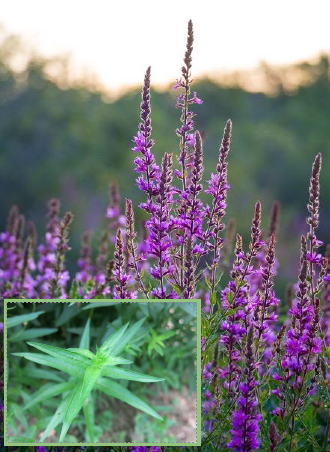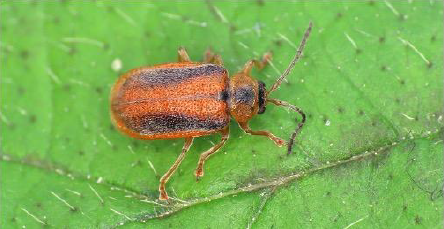
Factsheets and Publications
PURPLE LOOSESTRIFE
Scientific Name: Lythrum salicaria L.
Common Names: Purple loosestrife, Spiked loosestrife, Rainbow weed, Purple lythrum

Description
PURPLE LOOSESTRIFE is an herbaceous perennial plant characterized by a four-sided stem and long terminal spikes, each of which are surrounded by dense clusters of pink to magenta flowers. Each flower has 5 to 7 narrow, wrinkled petals. Flowering occurs 8-10 weeks after initial spring growth and begins in late June and continues through September. The leaves of the purple loosestrife plant are hairy and can appear both in opposite pairs that alternate down the stem or in whorls of 3 to 4. Though most rarely grow taller than 4 feet, in nutrient-rich habitats, some purple loosestrife can reach up to 10 feet tall. These plants spread primarily from seeds but are also capable of using underground shoots and the roots of established plants to spread as well. A mature purple loosestrife plant, which ranges from 1.5 to 6 feet tall, is capable of producing over 2,000,000 seeds which can remain viable in the soil for many years. Each seed has a 60-70% survival rate. Seed dispersal typically occurs along natural pathways, most specifically by drifting in moving water. However, when seeds embed themselves in mud, they can be easily picked up and transported by wildlife, humans, and vehicles.
Distribution
Native to Eurasia, purple loosestrife was introduced to North America by European settlers in the early to mid 1800’s. Its seeds were carried in ship ballast and on livestock that were brought to the United States for trade. Given its pharmacological and ornamental prowess, purple loosestrife has spread to almost every state in the United States – excluding Florida – as well as all Canadian provinces. In the state of Delaware, purple loosestrife appears all over New Castle County, but only sporadically in Kent and Sussex Counties.
Habitat
Purple loosestrife thrives in areas where soil is moist, including wet meadows, tidal and non-tidal marshes, river banks, reservoirs, river and stream banks, and the edges of ponds. The plant is able to tolerate shallow water depths, as well as a wide variety of moisture, nutrient, and climatic conditions. In addition to moist habitats, purple loosestrife also takes advantage of sites with high levels of disturbance as they serve as perfect places for seed germination.
Impacts
Once established in a particular area, purple loosestrife can displace native plant and animal species, greatly reduce biodiversity, degrade wetland habitats, and block irrigation channels and waterways.
Purple loosestrife can form dense, monospecific stands that help to crowd out native wetland vegetation, like sedges, cattails, grasses, and rushes.
The plant itself is of little to no value for wildlife, both as a viable habitat and food source.
As purple loosestrife spreads, it can fill in wetland ecosystems, which drastically reduces flood retention.
Purple loosestrife can trap sediments, causing the aquatic ecosystem it is growing in to become increasingly shallow.

Management
Chemical Control: For purple loosestrife populations greater than one acre, herbicides serve as an effective chemical control method. Glyphosate-based herbicides have proven to be effective at removing purple loosestrife, especially when applied to cut stems. However, only formulations labeled for aquatic use can be applied to plants in or around water.
Physical Control: Smaller infestations of purple loosestrife, limited to less than 100 plants, can be managed using physical control methods like hand pulling, flower removal, and digging up stem bases. However, it is important to not implement these control methods when purple loosestrife seed production is occurring since that will only help increase seed dispersal and, as a result, trigger new infestations to form.
Biological Control: In 1992, the United States Department of Agriculture (USDA) approved several European beetle species to be used for the biological control of purple loosestrife. Galerucella calmariensis and G. pusilla feed on every part of the plant, which prevents it from dispersing its seeds. A species of root-eating weevils, Hylobius transversovittatus, was also introduced. The weevil destroys the roots of purple loosestrife plants, killing them before they can infest new aquatic environments.
Author(s)
Wylie Feaster
Revision Date
7/14/2021
Original Publication Date: July 2020
UD Cooperative Extension
This institution is an equal opportunity provider.
In accordance with Federal law and U.S. Department of Agriculture policy, Cooperative Extension is prohibited from discriminating on the basis of race, color, national origin, sex, age, or disability.
